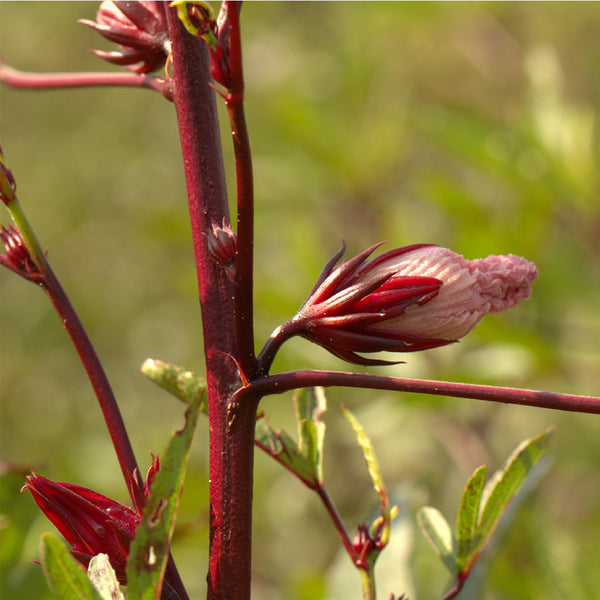Don’t let the pretty name fool you: hibiscus sabdariffa is a seriously powerful ingredient. Also known as roselle (another great name), the plant both exfoliates and moisturizes your skin. Not your average flower, it has been used across the globe for centuries for its healing properties, and provides just the boost your skin needs.
Background
Whether in person or on Pinterest boards, you’ve probably seen the hibiscus flower. With more than 5,000 hybrids, hibiscuses appear in a range of colors and flourish in warm, tropical places.
Hibiscus sabdariffa, of the Malvaceae family, is found most frequently in developing countries, prized for the fact that it grows easily and can be utilized in a variety of ways. Native to India through Malaysia, the plant was brought to Africa at a very early date. In fact, a Flemish botanist made his observations about roselle all the way back in 1576; by the 19th century, there were already factories manufacturing the plant’s jam.[1]
Roselle boasts strikingly red stems and leaves, alongside pale yellow flowers, and often grows as tall as eight feet. Although the plant won’t fit in any of your vases – we assume – it has a multitude of effective purposes.
In addition to its leaves and seeds being used in food, Hibiscus sabdariffa offers significant medicinal value, particularly in the herbs found in the plant’s calyces, or the bulb-like leaves that protect the flower. The ingredients are used to treat many different ailments and conditions, from liver disorders to high blood pressure to drunkenness. Besides fighting your next hangover, these healing properties can do wonders for your skin.

Skin Benefits
Paired with LXMI’s signature moisturizing ingredient, Nilotica, alongside the anti-aging Vanilla Planifolia, the Hibiscus sabdariffa in our Crème du Nil simultaneously works to exfoliate and moisturize. Sourced from Uganda, all the ingredients work together in harmony to protect your skin.
Hibiscus sabdariffa works as an anti-oxidant and an anti-inflammatory agent. The hibiscus’s signature red calyses are filled with antioxidants, including flavonoids, gossypetine, hibiscetine and sabdaretine.[2] Clinical studies have also shown that roselle is packed with anti-inflammatory properties by noting that the ingredient produces a decrease in MCP-1 concentration, an evaluator of inflammatory diseases.[3] Inflammation, whether chronic or acute, can cause serious problems from redness to aging – making these anti-inflammatory ingredients a must when it comes to your skin.[4]
Roselle is also loaded with skin-boosting acids. For instance, it contains citric acid, which transforms it into a cooling agent. During warmer days, it actually increases blood flow to the skin and dilates the pores to cool you off![5]
Next time you reach for a product to improve your skin, make sure you’ve got something with some real flower power.
[1] Morton, Julia F. (1987). Roselle. Fruits of Warm Climates, 281-6.
[2] Qi, Yadong & Chin, Kit L. & Malekian, Fatemah & Berhane, Mila & Gager, Janet. (2005). “Biological Characteristics, Nutritional and Medicinal Value of Roselle, Hibiscus Sabdariffa.” Circular – Urban Forestry Natural Resources and Environment No. 604.
[3] Da-Costa-Rocha, Inês & Bonnlaender, Bernd & Sievers, Hartwig & Pischel, Ivo and Heinrch, Michael. (2014). “Hibiscus sabdariffia L. – A phytochemical and pharmacological review.” Food Chemistry
[5] Morton, Julia F. (1987). Roselle. Fruits of Warm Climates, 281-6.






Fascinating. In the caribbean, the calyces are boiled and made into tasty drink around the Christmas season. The calyces are then used to make jam.
Sade on